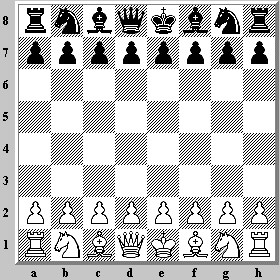The
hedgehog structure is characterized by Black's pawns on a6-b6-d6-e6,
covering some central squares and preventing White's forces from
approaching, like a real hedgehog does! Advancing several adjacent
pawns to the 3rd rank would generally be a bad decision. For example,
moving kingside pawns to h6-g6-f6-e6 would be a major positional
mistake as it creates multiple weaknesses. Here this is not the case,
as the natural arrangement of Black's pieces allows for the pawns to
be defended rather easily, while keeping a variety of active plans at
hand. White generally has a spatial advantage in the hedgehog, and
Black's main plan is to break in the centre with ... d6-d5, or
sometimes ... b6-b5. White will typically arrange his pieces to
prevent such plans, while keeping the game tense and flexible. Now,
let's discuss specific lines of action for each side.
White's
plans :
1.
Break on the queenside with c4-c5.
2.
Break on the queenside with b4-b5.
3.
Break on the queenside with a4-a5.
4.
Pressure the d6-pawn, but only after some pieces have been traded.
Black's
plans :
1.
Break in the centre with ... d6-d5.
2.
Break on the queenside with ... b6-b5.
3.
Create a kingside attack with ... iih8, ... E:g8 and ... g7-g5-g4. Or
maybe with ... h7-h5-h4-h3.
4.
Prepare all the plans above without actually executing any of them
until the right opportunity comes.
White's
Plans 1 -3 are often based on arranging pieces actively to
subsequently open up the queenside. Such action often gives White a
big advantage because Black's pieces are not as active due to their
limited space. The most common of these breaks is c4-c5, which
typically opens the b- and c-files. White's fourth plan is not as
easy to implement because the d6-pawn is not always vulnerable. Black
will usually have a bishop on e7 {or c7) which easily protects this
pawn from the attack of rooks down the d-file. In addition, the
breaks ... b6-b5 and ... d6-d.5 are powerful, drawing attention away
from this small vulnerability. However, after some pieces are traded,
Black's chances of counterplay lose strength, giving more importance
to a vulnerable d6-pawn.
If
White's bishop is on the fl -a6 diagonal, Black's first plan is the
most important. This plan is strong that White players will devote a
great deal of energy to fight against it. In most cases White will
be able to prevent this break, and Black will need a new plan to
create counterplay. A popular option is to create kingside threats
with the third plan. This plan often yields double-edged positions
where a single slip can be very costly for either side. As we will
learn in this chapter, if White cannot fight this plan with a
queenside reaction, then Black's kingside play will give him an
excellent position.
If
White's bishop is on g2, then the ... d6-d5 break is much more
difficult to carry out, but then Black's plan second plan (the ...
b6-b5 break) gains strength. As long as White does not have a bishop
on the fl -a6 diagonal, this break is likely to work well. Something
to notice is that if White has played g2-g3 and g2, then Black's plan
of ... !l:g8 and ... g7-g5-g4 does not really hit anything, hence it
should not be attempted at all.
Finally,
something to mention about Black's position is its flexibility. Often
White will find ways to prevent or undermine Black's attempts for
counterplay. In such cases, Black can often just wait and attempt new
plans without damaging his position. In many cases it is better for
Black to continue preparing his plans, or to start a new plan, than
to execute a plan under unfavourable circumstances; this is the
essence of the fourth plan.







